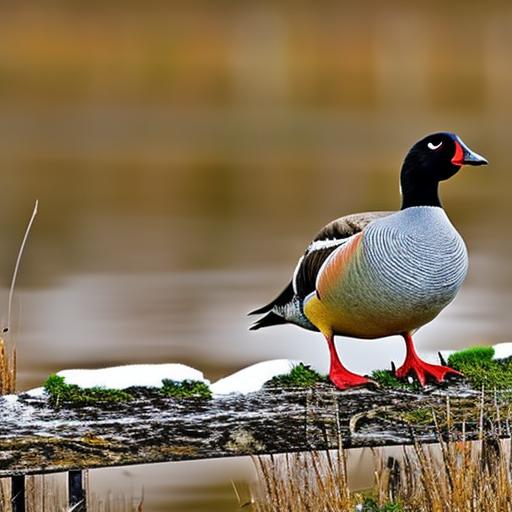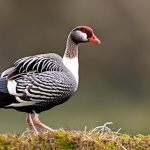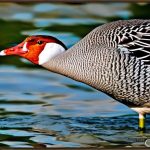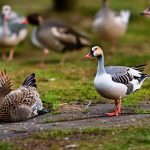Canadian geese are a common sight in many parts of Canada, but their populations can sometimes become overwhelming. Understanding and managing these populations is important for a variety of reasons. In this article, we will explore the behavior of Canadian geese, discuss methods for deterring them from properties, and examine the importance of properly managing their populations.
Key Takeaways
- Canadian geese are attracted to open spaces near water and grassy areas.
- Natural deterrents like landscaping and noise can help keep geese away.
- Physical barriers like fences and netting can prevent geese from accessing certain areas.
- Scare tactics like decoys and lasers can be effective in deterring geese.
- Safe and humane methods like egg addling and habitat modification can control geese populations.
Understanding the Behavior of Canadian Geese
Canadian geese are native to North America and are known for their distinctive honking sound and V-shaped flight formations. They typically inhabit wetland areas such as lakes, ponds, and rivers, but can also be found in urban areas where there is ample food and water. During the winter months, many Canadian geese migrate to warmer climates, while others remain in Canada year-round.
Canadian geese are highly social animals and live in large flocks. They communicate with each other through a variety of vocalizations and body language. They are also known for their aggressive behavior, especially during nesting season when they are protecting their young. These behaviors can contribute to geese infestations in certain areas.
Natural Deterrents to Keep Canadian Geese Away
There are several natural deterrents that can be used to keep Canadian geese away from properties. One effective method is to use landscaping techniques that make the area less attractive to geese. This can include planting tall grasses or shrubs near bodies of water, as geese prefer open spaces where they can easily spot predators.
Another natural deterrent is plant selection. Geese are attracted to certain types of grasses and plants, so choosing varieties that they dislike can help deter them from an area. For example, geese tend to avoid plants with prickly or thorny leaves.
Water management is also an important aspect of deterring geese. Geese are attracted to bodies of water for both drinking and feeding purposes. By reducing the amount of open water on a property, such as by installing fountains or water features that create movement, geese are less likely to be attracted to the area.
Creating Physical Barriers to Prevent Geese Infestation
In addition to natural deterrents, physical barriers can be used to prevent geese infestations. Fencing options can be effective in keeping geese out of certain areas. This can include installing low fences around bodies of water or gardens, or using taller fences to create a barrier between geese and a property.
Netting and mesh barriers can also be used to prevent geese from accessing certain areas. These barriers can be installed over bodies of water or gardens to prevent geese from landing or feeding. They are often used in combination with other deterrent methods for maximum effectiveness.
Other physical barriers that can be used include scarecrows or decoys that resemble predators, such as coyotes or owls. These deterrents can be effective in tricking geese into thinking there is a threat present and encourage them to move elsewhere.
Scare Tactics for Deterring Canadian Geese
Scare tactics can also be used to deter Canadian geese from properties. Visual deterrents, such as reflective tape or balloons, can be effective in scaring geese away. These items create movement and reflect light, which can make geese feel uneasy and encourage them to leave the area.
Auditory deterrents, such as noise-making devices or recordings of predator calls, can also be effective in deterring geese. These deterrents mimic the sounds of natural predators and can make geese feel threatened.
Motion deterrents, such as sprinklers or motion-activated lights, can also be effective in scaring geese away. These deterrents create sudden movements or flashes of light, which can startle geese and encourage them to leave the area.
Safe and Humane Methods for Geese Control
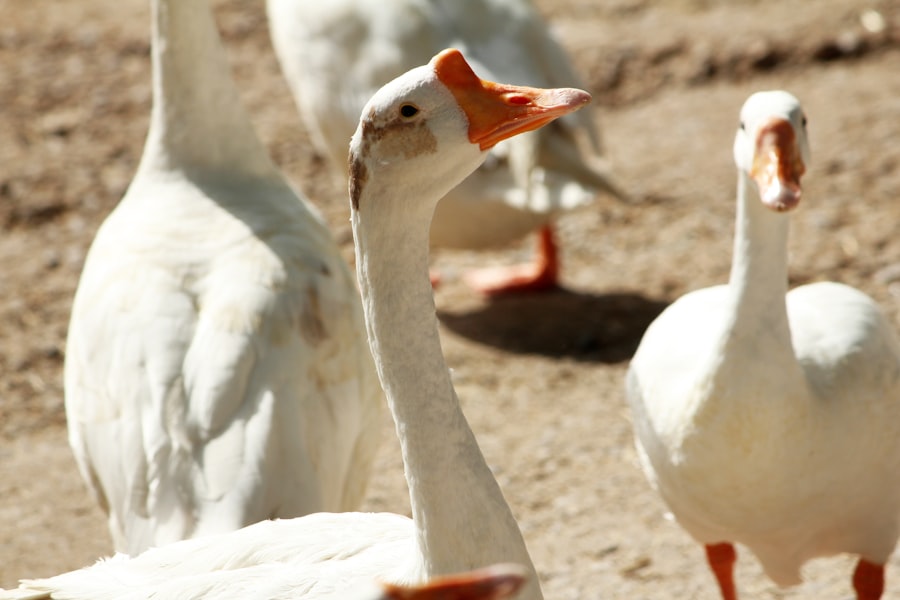
It is important to prioritize the safety and well-being of Canadian geese when implementing control methods. Non-lethal methods should always be used to deter geese from properties. This includes using deterrents that do not cause harm to the geese, such as visual or auditory deterrents.
There are many benefits to using humane methods for geese control. By avoiding harm to the geese, we can maintain a balance in the ecosystem and ensure the long-term health of the population. Humane methods also promote a positive image for property owners and communities, as they demonstrate a commitment to wildlife conservation.
Importance of Properly Managing Geese Populations
Properly managing geese populations is crucial for a variety of reasons. Geese infestations can have negative impacts on both natural ecosystems and human environments. Geese can cause damage to vegetation, create unsightly messes with their droppings, and pose a risk to human health and safety.
By implementing effective geese control measures, we can reduce these negative impacts and create a more harmonious coexistence with these birds. Proper management also allows us to maintain healthy ecosystems and protect other wildlife species that may be negatively affected by geese infestations.
Tips for Maintaining a Goose-Free Property
Maintaining a goose-free property requires regular maintenance and consistent use of deterrents. Regularly cleaning up any food sources or debris that may attract geese is important in preventing infestations. This includes removing fallen fruit or seeds, cleaning up spilled birdseed, and keeping garbage cans securely closed.
Consistently using deterrents, such as visual or auditory deterrents, can help reinforce the message that an area is not suitable for geese. It is important to regularly check and maintain these deterrents to ensure their effectiveness.
Encouraging geese to move to natural habitats is another effective method for maintaining a goose-free property. This can be done by creating alternative habitats nearby, such as by installing nesting boxes or providing food sources away from the property.
Working with Professional Wildlife Control Services
In some cases, it may be necessary to seek the assistance of professional wildlife control services to effectively manage geese populations. These services have the expertise and experience to implement a variety of control methods and can provide guidance on the most effective strategies for a specific property.
When choosing a professional service provider, it is important to consider their experience with geese control and their commitment to using humane methods. It is also important to consider the cost of these services and whether they fit within your budget.
Legal Considerations When Dealing with Canadian Geese
When dealing with Canadian geese, it is important to be aware of federal and provincial regulations regarding their management. In Canada, geese are protected under the Migratory Birds Convention Act, which prohibits the harming or disturbing of migratory birds without a permit.
Permits and licenses may be required for certain control methods, such as egg addling or nest removal. It is important to consult with local authorities or wildlife agencies to ensure compliance with these regulations.
Liability issues should also be considered when implementing geese control measures. Property owners have a responsibility to ensure the safety of their premises, and if someone is injured due to a geese-related incident, they may be held liable. Taking proactive measures to prevent geese infestations can help mitigate these risks.
Environmental Impact of Geese Infestations and Solutions
Geese infestations can have a significant impact on the environment. They can cause damage to vegetation by overgrazing or trampling, which can disrupt natural ecosystems. Geese droppings can also contribute to water pollution, as they contain high levels of nitrogen and phosphorus.
Sustainable solutions for geese control should be considered to minimize these environmental impacts. This can include implementing natural deterrents, such as landscaping techniques or plant selection, that do not harm the environment. It can also involve promoting the use of non-toxic deterrents and avoiding the use of chemicals or pesticides that may harm other wildlife species.
Understanding and managing Canadian geese populations is important for maintaining a healthy balance in our ecosystems and creating safe and enjoyable environments for both humans and wildlife. By implementing effective deterrents, creating physical barriers, and using scare tactics, we can prevent geese infestations and minimize their negative impacts.
It is crucial to prioritize the safety and well-being of geese when implementing control methods, and to use humane and non-lethal methods whenever possible. Properly managing geese populations not only benefits the environment, but also promotes a positive image for property owners and communities.
By taking action to deter geese from properties and working with professional wildlife control services when necessary, we can create a more harmonious coexistence with these birds. It is important to be aware of legal considerations and to implement sustainable solutions that minimize environmental impacts. With these efforts, we can effectively manage Canadian geese populations and create a better future for both humans and wildlife.
If you’re looking for ways to keep Canadian geese away from your property, you may also be interested in learning how to insulate a chicken coop. A well-insulated coop not only provides warmth and comfort for your chickens but can also act as a deterrent for unwanted visitors like geese. Check out this informative article on Poultry Wizard’s website: How to Insulate a Chicken Coop. While you’re there, you might also want to explore other helpful articles such as When Do Guinea Fowl Lay Eggs? and Rent a Chicken Coop.
FAQs
What are Canadian geese?
Canadian geese, also known as Canada geese, are a species of waterfowl native to North America. They are known for their distinctive black heads and necks, white chinstrap markings, and brownish-gray bodies.
Why do people want to keep Canadian geese away?
Canadian geese can cause damage to property, create health hazards with their droppings, and become aggressive towards humans during nesting season. Additionally, their large populations can lead to overgrazing and damage to natural habitats.
What are some methods for keeping Canadian geese away?
Some methods for keeping Canadian geese away include using visual deterrents such as scarecrows or reflective tape, using noise deterrents such as loud noises or predator calls, and using physical barriers such as fencing or netting.
Is it legal to harm or kill Canadian geese?
No, it is illegal to harm or kill Canadian geese without a permit from the appropriate wildlife agency. Canadian geese are protected under the Migratory Bird Treaty Act, which prohibits the hunting, killing, or possession of migratory birds without a permit.
What should I do if I encounter an aggressive Canadian goose?
If you encounter an aggressive Canadian goose, it is best to slowly back away and avoid making direct eye contact. Do not attempt to feed or touch the goose, as this can further agitate it. If the goose continues to be aggressive, seek assistance from a wildlife professional or animal control agency.
Meet Walter, the feathered-friend fanatic of Florida! Nestled in the sunshine state, Walter struts through life with his feathered companions, clucking his way to happiness. With a coop that’s fancier than a five-star hotel, he’s the Don Juan of the chicken world. When he’s not teaching his hens to do the cha-cha, you’ll find him in a heated debate with his prized rooster, Sir Clucks-a-Lot. Walter’s poultry passion is no yolk; he’s the sunny-side-up guy you never knew you needed in your flock of friends!

